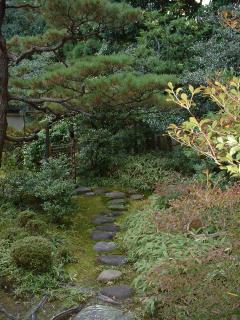How the features in a tea garden help prepare guests for the tea ceremony (course work)
The tea ceremony was introduced into Japan from China in the thirteenth century, by the founder of the Rinzai school of Zen. His disciple, Dogen (who founded Soto Zen) included instructions for a tea ceremony as part of the rules for his temple. This ceremony developed over several hundred years, and eventually tea houses were built separate from the temples. In the sixteenth century, Sen no Rikyu was responsible for introducing the style of cultured simplicity that still characterises the tea ceremony today.
The design of the garden surrounding the tea house should ensure that the guest arrives for the ceremony in a contemplative frame of mind. The walk through the garden can be seen as a twofold journey: towards not only the tea ceremony itself, but also the spiritual freedom offered through the correct use of meditation within the ritual. Mindfulness and stillness allow a state of tranquillity to arise, therefore the garden will be planned with the aim of encouraging quiet and harmony.
The first glimpse of the garden will give an impression of being in unspoilt mountainous forest and remote countryside scenery. Stepping through a torii gate will remind the visitor that a sacred space is being entered, and connections with the outside world can be released. To emphasise this letting go of ordinary things, a chiriana may soon be encountered. This may be translated as a waste or dust hole. Whilst ostensibly being provided as a receptacle for swept twigs and leaves, it is a symbol of a place where mental rubbish and concerns may be deposited.

The path itself, or roji, will be a narrow, winding path through the garden, often made up of stepping stones. These have the effect of focussing the attention on the feet (walking to mindfulness being a facet of meditation in most schools of Buddhism). This refining of concentration may be heightened by irregular spacing of the stones, rendering inattentive and automatic walking impossible! By slowing the pace down, the surroundings will be more easily appreciated. The path is designed with do and gaku very much at the forefront of any decisions on placement, as the roji may be considered to be symbolic of the guests journey not only toward the interior of the garden, but also of himself. Sprinkling the path with water will alter the mood of the whole garden, and the emotions aroused in the guest.
Another important traditional element is that of the stone water basin. This is intended for the ritual washing of hands (and maybe mouth) which is obviously a gesture of purification especially in Shinto, and cleansing of the body and mental defilements. The basin may be a chozubachi – a hollowed out rectangular stone. This could have a practical function for washing hands after work in the garden, or as a source of water for sprinkling over the stones in the garden. A tsukubai is a water basin set deliberately low to engender a humble state as the guest bends low to use it.

The water basin will probably have a lantern set beside to cast a light upon it. The tea ceremony was not only performed in daylight but after dark too, so candles would have been in placed in stone lanterns to light the path. Small oki-gata would be placed at a turn in the path, or near water.
The tea house itself, by its architecture and design, should remind the guest of a rustic cottage, simple and unpretentious. The garden would be enclosed by a bamboo fence, which will emphasise the division between the outside world and the inner space of tranquillity and serenity.

Each of the elements found in the tea garden should not be placed haphazardly. Their function will dictate their general situation, but the principles of do, gaku and jutsu will ensure that their relationship with each other and with the intimate landscape is harmonious and uncluttered. Each feature will enhance the chosen mood of the garden, which will ensure that the guest arrives at the tea house in an appropriately mindful state, and thus fully able to appreciate the beauty and simplicity of the tea ceremony



1 Comments:
Having spent some time In Kyoto your pictures bring back warm feelings. Nice shots
By Zen, at 11/7/06 8:41 pm
Zen, at 11/7/06 8:41 pm
Post a Comment
<< Home